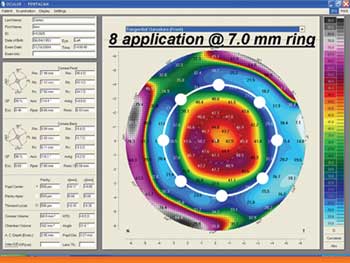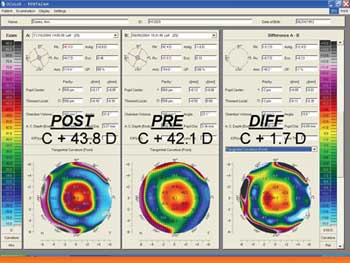Optics of conductive keratoplasty bring added benefits
The procedure takes advantage of optical characteristics of the eye to provide near and far vision in varied lighting conditions.
There are more than 73 million presbyopes in Europe – that represents a large group of consumers who are most likely frustrated with how their near vision has deteriorated as they have aged. While purchasing reading glasses from the chemist or pharmacy is the most common step most of these consumers will take to deal with the loss of near vision, there is another option.
In the past 2 years, I have incorporated NearVision CK, performed with the Refractec ViewPoint system, into my practice as a treatment option for presbyopes. This minimally invasive procedure is approved by the Food and Drug Administration for treatment of presbyopia. I became interested in the technology after hearing a colleague present on the topic, and I became convinced about the technology after exploring how NearVision CK influences the optical qualities of the cornea.
Treatment option tradeoffs
There are a growing number of treatment options for presbyopia, which is a reflection on the aging of the baby boomers. This is a group of people who have high expectations of life and are frustrated when they suddenly find themselves reliant on reading glasses to perform simple, daily tasks. As important, this is also a fairly affluent group, so they have the means to fix things when they are not happy.
The problem with many presbyopic treatments is that there are visual tradeoffs with which the patient will have to learn to live. With presbyopic LASIK, which is still in clinical trials, patients can experience a loss of contrast sensitivity, as well as dysphotopsia. Patients implanted with multifocal IOLs frequently experience the same side effects.
Accommodating IOLs are another option. With a smaller optic (4.5 mm vs. 6 mm) the eyeonics crystalens has a 25% greater depth of focus than a monofocal IOL. This effect is similar to that of the lens aperture of a camera: The smaller the opening, the greater the depth of focus. With a 4.5 mm optic, between 70% and 80% of patients implanted with the crystalens will be able to read J4, whereas with a monofocal IOL it is about 40%.
What impressed me when I first saw the results with NearVision CK was that a large percentage of patients had great distance and near vision. At 1 year after implantation, about 90% had 20/20 binocular distance vision and about the same percentage had binocular near vision of J3 or better. These were notable results because I had never seen anything close with other treatments for presbyopia. I was impressed, but I wanted to gain a better understanding what exactly was happening with the eye’s optics as a result of NearVision CK.
|
Images: Holladay JT |
Optical changes
To analyze the optical changes taking place in the cornea, I used a new diagnostic instrument, the Oculus Pentacam tomographer, that I was evaluating at the time. This instrument maps the anterior and posterior surfaces of the cornea and measures corneal thickness using a Scheimpflug scanning process. Unlike traditional corneal topographers, the Pentacam does not have a central blind spot and can image the entire cornea. With most Placido disk topographers, the central 1.6-mm to 2.2-mm zone is extrapolated data.
What I discovered is that the application of NearVision CK creates a flattened area at the 7-mm treatment zone. Inside that flattened ring there is significant steepening, except for the central 1 mm to 2 mm, where it is flatter.
The interesting fact here is that the power change created by NearVision CK is greater at the periphery than it is at the central cornea. So, for example, we measured a 1.7 D increase in power in the central cornea, an increase of 2 D to 2.20 D out toward the periphery of the treatment zone, and almost no change in dioptric power at 6 mm to 6.5 mm.
Based on the anterior surface corneal maps from the Pentacam, I concluded that what is happening with NearVision CK is that it is causing an exaggeration of the normal prolate shape of the cornea, creating negative spherical aberration, which is beneficial. When we looked at the posterior corneal surface maps, we also discovered that NearVision CK had a minimal effect on the back of the cornea, which increases the effectiveness of the treatment. A treatment that had more of an effect on the posterior cornea would subtract from the power increase on the anterior surface.
There is also a bit of serendipity involved in how NearVision CK works because it enables the eye to take advantage of the synkinetic reflex. Three things happen when we read: Our pupils get smaller, we accommodate, and our eyes converge. The constriction of the pupil creates a pinhole effect that results in an increase in depth of field of 1.25 D to 1.50 D in bright light. However, in dim light conditions, such as in a restaurant reading a menu or driving at night, the pupil remains at 3 mm to 5 mm.
The serendipity of the NearVision CK procedure is that the majority of the change in corneal power is at 3.5 mm to 4 mm, giving the eye the ability to focus under these varying lighting conditions. The increase in paracentral power of the cornea improves the near vision.
From an optics perspective, this explains why the cornea after NearVision CK is able to perform so well at varying light levels and distances. The procedure helps to create a truly pupil-dependent multifocal aspheric cornea — something that other procedures have not been able to achieve to date. The results demonstrate that at least 80% of patients lost just two lines of distance vision while gaining between seven and nine lines of near vision.
Procedural pointers
There are a couple of pointers that will help to ensure success with NearVision CK.
First, it is important to make sure that your corneal marking is perfectly centered on the pupil and the application points made perpendicular to the cornea at that point. If it is not a perfect circle, you will induce astigmatism. It is a good idea to avoid patients with high levels of astigmatism until you have built experience with the procedure.
I also recommend the use of the LightTouch technique. With this technique, you create an indentation on the cornea of no more than 2 mm around the probe initially and then withdraw until there is no indentation. This avoids stretching the collagen fibers, thus producing a more robust treatment effect with few treatment rings. Use of the LightTouch technique can dramatically help to improve the predictability of NearVision CK.
Finally, when we have presbyopic patients who are interested in having LASIK, we perform LASIK in both eyes to make them emmetropic, and then we have them come back 6 months later for a NearVision CK procedure in their nondominant eye. This helps to maintain their distance vision while still providing near vision and depth perception. Most are happy to wait those 6 months for the result to be predictable.
Based on my personal experience, as well as my investigation of the optical qualities of NearVision CK, I can honestly say that this is the first treatment that maintains depth perception in both eyes while providing patients with the ability to read without glasses or contact lenses.
For more information:
- Jack T. Holladay, MD, MSEE, FACS, is president of the Holladay LASIK Institute in Bellaire, Texas and a clinical professor of ophthalmology at the Baylor College of Medicine in Houston. He can be reached at Holladay LASIK Institute, Bellaire Triangle Building, 6802 Mapleridge, Suite 200, Bellaire, TX 77401 U.S.A.; +1-713-668-7337; fax: +1-713-668-7336; e-mail: docholladay@docholladay.com; Web site: www.docholladay.com. Dr. Holladay has no financial interest in the products discussed in this article.
- Refractec, manufacturer of NearVision CK, can be reached at 5 Jenner, Suite 150. Irvine, CA 92618 U.S.A.; +1-949-784-2600; fax: +1-949-784-2601; Web site: www.refractec.com.


